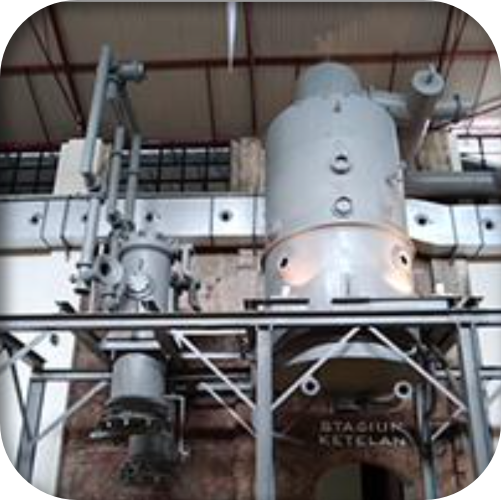De Tjolomadeo: The Machinery Utilization on The Concept of Sugar Factory Adaptive Reuse De Tjolomadoe: Pemanfaatan Mesin Pada Konsep Adaptive Reuse Pabrik Gula
Main Article Content
Abstract
One concept for utilizing heritage buildings is adaptive reuse. It is applied to industrial heritage such as the Colomadu Sugar Factory. For a long time, the building was abandoned and unproductive. This study aims to examine the changes in the function of the ex-sugar factory machines and their role in the interior design of De Tjolomadoe. The research method uses qualitative methods to identify changes in the function of ex-sugar factory machines as current interior elements. The building is brought back to life with a new spirit. Machines from the former sugar factory are maintained and given new functions, which includes: as a supporting element of the sense of place, museum collections, aesthetic elements, and furniture design. The existence of ex-sugar factory machines is an important and unique interior element as well as authentic proof of the glory of the sugar factory.
Article Details

This work is licensed under a Creative Commons Attribution-NonCommercial-ShareAlike 4.0 International License.
References
Aratuza, K. S. (2021). Kajian heterotopia pada pabrik gula Colomadu. Syntax Literate : Jurnal Ilmiah Indonesia, 6(12), 6197–6213. https://doi.org/http://dx.doi.org/10.36418/syntax-literate.v6i12.5047
Ardhiati, Y. (2018). De Tjolomadoe: adaptive reuse bangunan cagar budaya. Wastu Adicitta.
Ardhiati, Y., Ashri, P. D., Prasetya, L. E., & Kurniawan, F. (2020). Imaginary vs. traditional museum: the historical heritage-based design. Proceedings of the International Conference of Heritage & Culture in Integrated Rural-Urban Context (HUNIAN 2019), 195(Hunian 2019), 1–7. https://doi.org/10.2991/aer.k.200729.001
Ardhiati, Y., Damayant, S., Anggita, D., Wibisono, A. I., Isna, R., Fajarwati, A. A. S., & Lestariningsih, A. D. (2020). “De Tjolomadoe”: from cultural heritage to industry 4.0. Journal of Applied Science and Advanced Technology, 3(1), 1–8.
Atmodiwirjo, P., & Yatmo, Y. A. (2022). Responsive interior: tactics for adaptation and resilience. Interiority, 5(2), 133–136. https://doi.org/10.7454/in.v5i2.238
Bahauddin, A., Prihatmanti, R., & Putri, S. A. (2022). ‘Sense of place’ on sacred cultural and architectural heritage: St. Peter’s church of Melaka. Interiority, 5(1), 53–74. https://doi.org/10.7454/in.v5i1.178
Chen, J., Judd, B., & Hawken, S. (2016). Adaptive reuse of industrial heritage for cultural purposes in Beijing, Shanghai and Chongqing. Structural Survey, 34(4–5), 331–350. https://doi.org/10.1108/SS-11-2015-0052
Cheris, R., Imbardi, I., & Ivan, L. M. (2021). Elemen arsitektur pembentuk karakter bangunan pada tapak warisan dunia kota Sawahlunto Sumatera Barat, Indonesia. Arsitektura, 19(1), 13–24. https://doi.org/10.20961/arst.v19i1.47961
Creswell, J. W. (2013). Qualitative inquiry & research design (3 rd). SAGE Publications, Inc.
Fajarwati, A. A. S., & Ardhiati, Y. (2021). Identitas dan material culture kelas pekerja pada situs De Tjolomadoe. JSRW (Jurnal Senirupa Warna), 9(1), 49–62. https://doi.org/10.36806/jsrw.v9i1.95
Fajarwati, A. A. S., & Kurnia, L. (2021). Transculturality through industrial space: Cembengan at the Colomadu sugar factory. Humaniora, 12(1), 45–51. https://doi.org/10.21512/humaniora.v12i1.6918
Fajarwati, A., & Wulandari, A. (2020). Adaptive reuse of Colomadu sugar factory: between preserving heritage and social media setting. IOP Conference Series: Earth and Environmental Science, 452(1), 1–7. https://doi.org/10.1088/1755-1315/452/1/012045
Holbrook, T. (2013). Kraftwerk: c-mine cultural centre, Genk, Belgium by 51N4E. The Architectural Review.
Hosper. (2012). Genk c-mine. ArchDaily.
ICOM. (2022). ICOM is pleased to announce that the proposal for the new museum definition was approved.
Iqbal, N., Akbar, S. H., & Cleempoel, K. Van. (2022). Identification of industrial heritage and a theoretical framework for an industrial heritage inventory system in Pakistan. Sustainability (Switzerland), 14(10), 1–19. https://doi.org/10.3390/su14105797
Martokusumo, W. (2014). Kota (pusaka) sebagai living museum. Temu Pusaka Indonesia 2014, September, 1–6.
Martokusumo, W., & Wibowo, A. S. (2021). Pelestarian arsitektur dan lingkungan bersejarah (E. Warsidi (ed.)). ITB Press.
Montgomery, J. (2003). Cultural quarters as mechanisms for urban regeneration. part 1: conceptualising cultural quarters. Planning Practice and Research, 18(4). https://doi.org/10.1080/1561426042000215614
Najafi, M., Kamal, M., & Mohd, B. (2011). The concept of place and sense of place in architectural studies. World Academy of Science, Engineering and Technology International Journal of Humanities and Social Sciences, 5(8), 1054–1060.
Nugroho, P. S., Yuliastuti, N., Rukayah, R. S., Nugroho, R., & Cahyono, U. J. (2020). Identifikasi pabrik gula sebagai industrial heritage di Jawa. Arsitektura, 18(1), 119–128. https://doi.org/10.20961/arst.v18i1.37936
Pitaloka, A. R., & Yusran, Y. A. (2019). Penilaian keaslian bangunan De Tjolomadoe menggunakan instrumen Nara grid. Review of Urbanism and Architectural Studies, 17(2), 27–40. https://doi.org/10.21776/ub.ruas.2019.017.02.3
Plevoets, B., & Van Cleempoel, K. (2011). Adaptive reuse as a strategy towards conservation of cultural heritage: a literature review’, in: ’structural studies, repairs and maintenance of heritage architecture XII. WIT Transactions on the Built Environment, 118, 155–164.
Pramudito, S., Kristiawan, Y. B., Wismarani, Y. B., & Analisa, F. C. K. (2020). Identifikasi aspek sense of place kawasan bersejarah berdasarkan preferensi pengujung (studi kasus: kawasan Sagan, Yogyakarta). Jurnal Arsitektur ARCADE, 4(3), 206–215. https://doi.org/10.31848/arcade.v4i3.526
Purnomo, A.D., Laksitarini, N., & Destyantari, L. (2022). DE Tjolomadoe – the heritage building with a new spirit. Embracing the Future: Creative Industries for Environment and Advanced Society 5.0 in a Post-Pandemic Era, 301–304. https://doi.org/10.1201/9781003263135-61
Purnomo, Agus Dody, Laksitarini, N., & Day, S. A. S. (2021). Implementasi adaptive reuse pada interior De Tjolomadoe. Prosiding Seminar Nasional Desain dan Arsitektur (SENADA), 4, 138–145.
Saputra, H., & Purwantiasning, A. W. (2013). Kajian konsep adaptive reuse sebagai alternatif aplikasi konsep konservasi. Jurnal Arsitektur Universitas Bandar Lampung, 4(1), 45–52.
Scannell, L., & Gifford, R. (2017). The psychology of place attachment. January 2014, 272–300.
TICCIH. (2003). Charte nizhny tagil pour le patrimoine industriel. July, 2–5.
Wakid, A. (2016). FABRIEK FIKR 2016 : begini kala pabrik gula Colomadu disulap jadi laboratorium seni. SOLOPOS.com.
Wasino. (2014). Modernisasi di jantung budaya Jawa - Mangkunegaran 1896-1944. Buku Kompas.
Widagdo. (2011). Desain dan kebudayaan. ITB Press.
Wong, L. (2017). Adaptive reuse - extending the lives of buildings. Birkhäuser Base.

